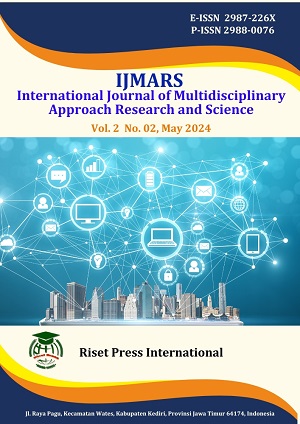Utilizing iSpring Suite to Develop MEDIFORA Android-Based Application as a Science Learning Media for Fourth Grade Elementary School Students
DOI:
https://doi.org/10.59653/ijmars.v2i02.790Keywords:
medifora application, learning media, science learning, android, elementary school, ispring suiteAbstract
The existence of the use of media in learning has been proven to be able to provide positive results on learning outcomes. The lack of learning media in accordance with the characteristics of the subject matter makes learning media rarely used in the learning process. The purpose of this study is to develop android-based learning media as an alternative to science learning media in elementary schools. The research method used in this study is Research and Development (R&D) which refers to the model developed by Sugiyono with 10 steps. Data collection instruments in the form of observations, validation sheets and student response questionnaires. The subjects of the study were students in grade 4 totaling 30 students at SDN 01 Kalibening Raya. The results of this study 0020 application named MEDIFORA with a feasibility rate by experts of 76.32% were declared feasible because they exceeded 61%. The effectiveness of the MEDIFORA Application seen from student learning results is obtained that MEDIFORA is effective which is shown by the level of completeness of student learning of 80%. Based on these results, it can be concluded that the MEDIFORA application can be used as an alternative science learning media for life cycle materials in grade 4 elementary schools.
Downloads
References
Afifah, N., Kurniaman, O., &; Noviana, E. (2022). Development of interactive learning media in learning Indonesian grade III elementary school. Journal of Educational Gait, 1(1), 33–42. https://doi.org/10.33578/kpd.v1i1.24
Destiniar, D., Rohana, R., &; Ardiansyah, H. (2021). Development of Android application-based learning media on material derived from algebraic functions. AXIOM: Journal of the Mathematics Education Study Program, 10(3), 1797. https://doi.org/10.24127/ajpm.v10i3.4050
Fadilah, Y. W., &; Sulaikho, S. (2022). Feasibility of Android-Based iSpring Suite Learning Media on Nahwu Shorof Subjects. Arabia: Journal of Arabic Language Education, 13(2), 315–338. https://doi.org/10.21043/arabia.v13i2.10710
Fikrotin, V., &; Sulaikho, S. (2021). Feasibility of Android-Based iSpring Suite Learning Media on Shorof Subjects. Al-Ittijah: Journal of Arabic Science and Education, 13(2), 95–118.
Communication and Information. (2017). 10 Facts from Google about the Digital Population in Indonesia and the World. Media Spotlight. https://www.kominfo.go.id/content/detail/12148/10-fakta-dari-google-tentang-populasi-digital-di-indonesia-dan-dunia/0/sorotan_media
Communication and Information. (2022). Ensure Telecommunication Network Readiness, Kominfo Monitor Network and Public Complaints. Press Release NO. 546/HM/Kominfo/12/2022. https://www.kominfo.go.id/content/detail/46544/siaran-pers-no-546hmkominfo122022-tentang-pastikan-kesiapan-jaringan-telekomunikasi-kominfo-pantau-jaringan-dan-aduan-masyarakat/0/siaran_pers
Nurseto, T. (2012). Creating Interesting Learning Media. Journal of Economics and Education, 8(1), 19–35. https://doi.org/10.21831/jep.v8i1.706
Rahmi, M. S. M., Budiman, M. A., &; Widyaningrum, A. (2019). Development of Macromedia Flash 8 Interactive Learning Media on Thematic Learning My Experience Theme. International Journal of Elementary Education, 3(2), 178. https://doi.org/10.23887/ijee.v3i2.18524
Rohmani. (2019). Interactive Multimedia-Based Science Learning to Increase Student Interest and Achievement. Exponent, 9(1), 67–78. https://doi.org/10.47637/eksponen.v9i1.134
Rohmani, R., Apriza, B., &; Mahendra, Y. (2021). Game Development Educational Quizzes Textbook Supplement Introduction to Basic Science Based on Website. JINoP (Journal of Learning Innovation), 7(2), 194–208. https://doi.org/10.22219/jinop.v7i2.18576
Shi, A., Wang, Y., &; Ding, N. (2022). The effect of game–based immersive virtual reality learning environment on learning outcomes: Designing an intrinsic integrated educational game for pre-class learning. Interactive Learning Environments, 30(4), 721–734. https://doi.org/10.1080/10494820.2019.1681467
Sugiyono. (2016). Quantitative, Qualitative and R&D Research Methods. Alpha Beta.
Umam, I. M., &; Sulaikho, S. (2021). Feasibility of Android-Based iSpring Suite Learning Media in Fiqh Subjects. Al-Hayat: Journal of Islamic Education, 5(1), 122–131. https://doi.org/10.35723/ajie.v5i1.174
Vikulova, L., Makarova, I., &; Gerasimova, S. (2018). Features of iSpring suite learning platform for teaching foreign languages. Espacios, 39(20), 5–5.
Wahyuningtyas, N., &; Yahya, M. H. (2021). Development of the application "SIMBA" (Social studies instructional media based android) for class VII junior high school social studies subjects. JINoP (Journal of Learning Innovation), 7(2), 153–166. https://doi.org/10.22219/jinop.v7i2.15918
Downloads
Published
How to Cite
Issue
Section
Categories
License
Copyright (c) 2024 Rohmani, Purie Nawa Utami

This work is licensed under a Creative Commons Attribution-ShareAlike 4.0 International License.
Authors who publish with this journal agree to the following terms:
- Authors retain copyright and grant the journal right of first publication with the work simultaneously licensed under a Creative Commons Attribution-ShareAlike that allows others to share the work with an acknowledgement of the work's authorship and initial publication in this journal.
- Authors are able to enter into separate, additional contractual arrangements for the non-exclusive distribution of the journal's published version of the work (e.g., post it to an institutional repository or publish it in a book), with an acknowledgement of its initial publication in this journal.
- Authors are permitted and encouraged to post their work online (e.g., in institutional repositories or on their website) prior to and during the submission process, as it can lead to productive exchanges, as well as earlier and greater citation of published work (See The Effect of Open Access).
























